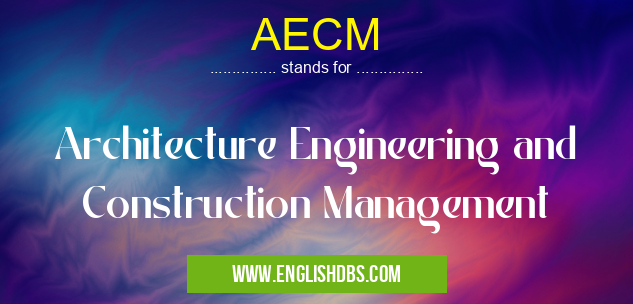What does AECM mean in ENGINEERING
AECM stands for Architecture, Engineering, and Construction Management. It encompasses a wide range of disciplines that collaborate to plan, design, build, and maintain the built environment.

AECM meaning in Engineering in Academic & Science
AECM mostly used in an acronym Engineering in Category Academic & Science that means Architecture Engineering and Construction Management
Shorthand: AECM,
Full Form: Architecture Engineering and Construction Management
For more information of "Architecture Engineering and Construction Management", see the section below.
Sub-Disciplines of AECM
AECM involves the following sub-disciplines:
- Architecture: Design and planning of buildings and other structures.
- Engineering: Structural, mechanical, electrical, and other engineering disciplines involved in the construction process.
- Construction Management: Planning, coordinating, and overseeing construction projects.
Importance of AECM
AECM plays a crucial role in:
- Creating functional and sustainable buildings and infrastructure.
- Enhancing project efficiency and reducing costs.
- Ensuring safety and quality in construction projects.
- Facilitating collaboration among project stakeholders.
Benefits of AECM
- Improved Project Outcomes: Cohesive collaboration among AECM professionals leads to better project planning, design, and execution.
- Reduced Costs and Timelines: Proper coordination and management minimize waste, delays, and budget overruns.
- Enhanced Safety: By adhering to safety regulations and best practices, AECM professionals create safer work environments and minimize accidents.
- Innovation and Sustainability: AECM fosters collaboration and encourages the adoption of innovative technologies and sustainable practices.
Essential Questions and Answers on Architecture Engineering and Construction Management in "SCIENCE»ENGINEERING"
What is AECM?
Architecture Engineering and Construction Management (AECM) is a multidisciplinary field that combines architecture, engineering, and construction management to deliver integrated building projects. It focuses on the planning, design, and management of the built environment, ensuring cost-efficiency, sustainability, and functionality.
What are the benefits of using AECM?
AECM offers numerous benefits, including:
- Enhanced collaboration and communication among project team members
- Improved project planning and execution
- Reduced costs and increased efficiency
- Improved building quality and performance
- Increased sustainability and environmental friendliness
What are the career opportunities in AECM?
AECM graduates have a wide range of career opportunities, including:
- Architects
- Engineers (structural, mechanical, electrical, civil)
- Construction managers
- Project managers
- Sustainability consultants
- Facility managers
What are the key skills required for AECM professionals?
Successful AECM professionals typically possess a strong foundation in:
- Architectural design
- Engineering principles
- Construction management practices
- Project planning and execution
- Communication and interpersonal skills
- Business acumen
What is the future of AECM?
The AECM industry is constantly evolving, driven by technological advancements and sustainability concerns. Emerging trends include:
- Digitalization and automation
- Building information modeling (BIM)
- Green building and sustainable design
- Smart cities and infrastructure
- Collaboration platforms and data analytics
Final Words: AECM is an interdisciplinary field that brings together professionals from various backgrounds to create and maintain the built environment. By combining architecture, engineering, and construction management, AECM professionals deliver high-quality, efficient, and sustainable projects that serve the needs of society.
AECM also stands for: |
|
| All stands for AECM |
